Greco-Bactrian Kingdom
Greco-Bactrian Kingdom | |||||||||||||
|---|---|---|---|---|---|---|---|---|---|---|---|---|---|
| Capital | Bactra Ai-Khanoum | ||||||||||||
| Common languages | Bactrian Greek Parthian Sanskrit (religion)[1] Sogdian | ||||||||||||
| Religion | Hellenism Greco-Buddhism Zoroastrianism Hinduism Ancient Iranian religion | ||||||||||||
| Government | Monarchy | ||||||||||||
| Basileus | |||||||||||||
• 256–239 BC | Diodotus I (first) | ||||||||||||
• 117–100 BC | Heliocles I (last) | ||||||||||||
| Historical era | Antiquity | ||||||||||||
• Established | 256 BC | ||||||||||||
• Disestablished | c. 120 BC | ||||||||||||
| Area | |||||||||||||
| 184 BC[2] | 2,500,000 km2 (970,000 sq mi) | ||||||||||||
| |||||||||||||
The Greco-Bactrian Kingdom or simply Greco-Bactria[3][4][a] was a Hellenistic-era Greek state,[5] and along with the Indo-Greek Kingdom, the easternmost part of the Hellenistic world in Central Asia and the Indian subcontinent. It was founded in 256 BC by the Seleucid satrap Diodotus I Soter and lasted until its fall c. 120 BC with some cities still controlled by Greek kings such as Hermaeus Soter (90-70 BC) in what is today Kabul. It was ruled by the Diodotid dynasty and the rival Euthydemid dynasty.
It covered much of present-day Afghanistan, Pakistan, Uzbekistan, Tajikistan, and Turkmenistan, and some parts of Kazakhstan and Iran. An extension further east, with military campaigns and settlements, had most likely reached the borders of the Qin State in 230 BC.[6][7] The capitals of Ai-Khanum and Bactra were among the largest and richest cities of antiquity; indeed, Bactria was itself known as the land of a thousand golden cities. The Indo-Greek Kingdoms, as Bactrian successor states, would last until 10 AD.[8][9][10]
History
Origins
Bactria was inhabited by Greek settlers since the times of Darius I, when the entire population of Barca, in Cyrenaica, was deported to the region for refusing to surrender assassins.[11] Greek influence increased under Xerxes I, after the descendants of Greek priests who had once lived near Didyma (western Asia Minor) were forcibly relocated in Bactria,[12] and later on with other exiled Greeks, most of them prisoners of war. Greeks communities and language were already common in the area by the time that Alexander the Great conquered Bactria in 328 BC.[13]
Independence and Diodotid dynasty
Diodotus, the
Diodotus, the governor of the thousand cities of Bactria (
Latin: Theodotus, mille urbium Bactrianarum praefectus), defected and proclaimed himself king; all the other people of the Orient followed his example and seceded from the Macedonians.[16]
The new kingdom, highly urbanized and considered one of the richest of the Orient (opulentissimum illud mille urbium Bactrianum imperium "The extremely prosperous Bactrian empire of the thousand cities", according to Justin[17]), was to further grow in power and engage in territorial expansion to the east and the west:
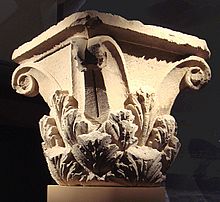
The Greeks who caused Bactria to revolt grew so powerful on account of the fertility of the country that they became masters, not only of
Oxus), and Darapsa, and several others. Among these was Eucratidia,[18] which was named after its ruler.[19]
In 247 BC, the
Diodotus was succeeded by his son Diodotus II, who allied himself with the Parthian Arsaces in his fight against Seleucus II:
Soon after, relieved by the death of Diodotus, Arsaces made peace and concluded an alliance with his son, also by the name of Diodotus; some time later he fought against Seleucos who came to punish the rebels, and he prevailed: the Parthians celebrated this day as the one that marked the beginning of their freedom.[20]
Euthydemid dynasty and Seleucid invasion
MIES
And they also held Sogdiana, situated above Bactriana towards the east between the Oxus River, which forms the boundary between the Bactrians and the Sogdians, and the
Iaxartes River. And the Iaxartes forms also the boundary between the Sogdians and the nomads.[23]
Euthydemus was attacked by the Seleucid ruler
... for if he did not yield to this demand, neither of them would be safe: Seeing that great hordes of Nomads were close at hand, who were a danger to both; and that if they admitted them into the country, it would certainly be utterly barbarised.[22]
In an inscription found in the
| Translation (English) |
|
|---|---|
| Transcription (original Greek script )
|
|
| Inscription (Greek language) |
 |
Following the departure of the Seleucid army, the Bactrian kingdom seems to have expanded. In the west, areas in north-eastern
Expansion into the Indian subcontinent (after 180 BC)
Demetrius may have been as far as the imperial capital
Eucratides
Back in Bactria,
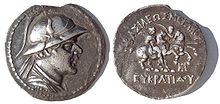
Eucratides led many wars with great courage, and, while weakened by them, was put under siege by Demetrius, king of the Indians. He made numerous sorties, and managed to vanquish 60,000 enemies with 300 soldiers, and thus liberated after four months, he put India under his rule.[33]
Eucratides campaigned extensively in present-day northwestern India, and ruled a vast territory, as indicated by his minting of coins in many Indian mints, possibly as far as the
In a rather confused account, Justin explains that Eucratides was killed on the field by "his son and joint king", who would be his own son, either Eucratides II or Heliocles I (although there are speculations that it could have been his enemy's son Demetrius II). The son drove over Eucratides' bloodied body with his chariot and left him dismembered without a sepulchre:
As Eucratides returned from India, he was killed on the way back by his son, whom he had associated to his rule, and who, without hiding his parricide, as if he didn't kill a father but an enemy, ran with his chariot over the blood of his father, and ordered the corpse to be left without a sepulture.[33]
Defeats by Parthia
During or after his Indian campaigns, Eucratides was attacked and defeated by the Parthian king Mithridates I, possibly in alliance with partisans of the Euthydemids:
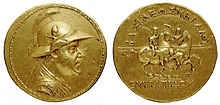
The Bactrians, involved in various wars, lost not only their rule but also their freedom, as, exhausted by their wars against the Sogdians, the Arachotes, the Dranges, the Arians and the Indians, they were finally crushed, as if drawn of all their blood, by an enemy weaker than them, the Parthians.[33]
Following his victory, Mithridates I gained Bactria's territory west of the
In the year 141 BC, the Greco-Bactrians seem to have entered in an alliance with the Seleucid king Demetrius II to fight again against Parthia:
The people of the Orient welcomed his (Demetrius II's) arrival, partly because of the cruelty of the Arsacid king of the Parthians, partly because, used to the rule of the Macedonians, they disliked the arrogance of this new people. Thus, Demetrius, supported by the Persians, Elymes and Bactrians, routed the Parthians in numerous battles. At the end, deceived by a false peace treaty, he was taken prisoner.[34]
The 5th century historian
Heliocles I ended up ruling what territory remained. The defeat, both in the west and the east, may have left Bactria very weakened and open to nomadic invasions.
Nomadic invasions
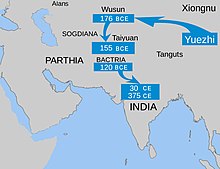
A nomadic steppe people called the
Around 140 BC, eastern
When the
According to Zhang Qian, the Yuezhi represented a considerable force of between 100,000 and 200,000 mounted archer warriors,
Daxia (Bactria) is located over 2,000
Records of the Great Historian by Sima Qian, quoting Zhang Qian, trans. Burton Watson)
The Yuezhi further expanded southward into Bactria around 120 BC, apparently further pushed out by invasions from the northern Wusun. It seems they also pushed Scythian tribes before them, which continued to India, where they came to be identified as Indo-Scythians.
The invasion is also described in western Classical sources from the 1st century BC:
The best known tribes are those who deprived the Greeks of Bactriana, the Asii, Pasiani,
Sogdiani.[38]
Around that time the king
Overall, the Yuezhi remained in Bactria for more than a century. They became Hellenized to some degree, as suggested by their adoption of the Greek alphabet to write their later Iranian court language,[39][40] and by numerous remaining coins, minted in the style of the Greco-Bactrian kings, with the text in Greek.
Around 12 BC the Yuezhi then moved further to northern India where they established the Kushan Empire.
Military forces

Before Greek conquest, the armies of Bactria were overwhelmingly composed of cavalry and were well known as effective soldiers, making up large portions of the
Alexander and
The army of the Greco-Bactrian kingdom was then a multi-ethnic force with Greek colonists making up large portions of the infantry as pike phalanxes, supported by light infantry units of local Bactrians and mercenary javelin-wielding
Culture and contacts
Greek culture in Bactria
Greeks first began settling the region long before Alexander conquered it. The
The Greco-Bactrians were known for their high level of
Their cities, such as
One of the inscriptions in Greek found at Ai-Khanoum, the Herôon of Kineas, has been dated to 300–250 BC, and describes Delphic precepts:
As children, learn good manners.
As young men, learn to control the passions.
In middle age, be just.
In old age, give good advice.
Then die, without regret.
Some of the Greco-Bactrian coins, and those of their successors the
Several other Greco-Bactrian cities have been further identified, as in
-
BronzeHeraklesstatuette. Ai Khanoum. 2nd century BC.
-
Sculpture of an old man, possibly a philosopher. Ai Khanoum, 2nd century BC.
-
Close-up of the same statue.
-
Frieze of a naked man wearing a chlamys. Ai Khanoum, 2nd century BC.
-
Gargoyle in the form of a Greek comic mask. Ai Khanoum, 2nd century BC.
-
Plate depicting Cybele pulled by lions. Ai Khanoum.
Takht-i Sangin
Takht-i Sangin (
-
Ionic pillar, cella of the Temple of the Oxus, Takht-i Sangin, late 4th - early 3rd century BCE.[43]
-
Head of aGreco-Bactrian ruler with diadem, Temple of the Oxus, Takht-i Sangin, 3rd–2nd century BCE. This could also be a portrait of Seleucus I.[45]
-
Hellenistic silenus Marsyas from Takhti Sangin, with dedication in Greek to the god of the Oxus, by "Atrosokes" (a Bactrian name). Temple of the Oxus, Takht-i Sangin, 200–150 BCE. Tajikistan National Museum.[43][46]
-
Alexander-Herakles head, Takht-i Sangin, Temple of the Oxus, 3rd century BCE.[43]
Contacts with the Han Empire
To the north, Euthydemus also ruled
Several statuettes and representations of Greek soldiers have been found north of the
Some speculate that Greek influence is found in the artworks of the burial site of China's first Emperor
The presence of Chinese people in India from ancient times is also suggested by the accounts of the "
"When I was in Bactria (
Shiji 123, Sima Qian, trans. Burton Watson).
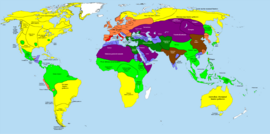
The purpose of Zhang Qian's journey was to look for civilizations on the steppe that the Han could ally with against the Xiongnu. Upon his return, Zhang Qian informed the Chinese emperor Han
The Son of Heaven on hearing all this reasoned thus:
Hanshu, Former Han History).
A number of Chinese envoys were then sent to Central Asia, triggering the development of the Silk Road from the end of the 2nd century BC.[56]
Contacts with the Indian subcontinent (250–180 BC)
The Indian emperor
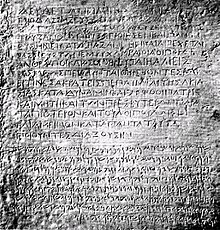
Chandragupta's grandson
The conquest by
Pandyas, and as far as Tamraparni. (Edicts of Ashoka, 13th Rock Edict, S. Dhammika).
Some of the Greek populations that had remained in northwestern India apparently converted to Buddhism:
Here in the king's domain among the Greeks, the
Andhras and the Palidas, everywhere people are following Beloved-of-the-Gods' instructions in Dharma. (Edicts of Ashoka, 13th Rock Edict, S. Dhammika).
Furthermore, according to Pali sources, some of Ashoka's emissaries were Greek Buddhist monks, indicating close religious exchanges between the two cultures:
When the thera (elder) Moggaliputta, the illuminator of the religion of the Conqueror (Ashoka), had brought the (third) council to an end ... he sent forth theras, one here and one there: ... and to Aparantaka (the "Western countries" corresponding to
Mahavamsa, XII).
Greco-Bactrians probably received these Buddhist emissaries (at least Maharakkhita, lit. "The Great Saved One", who was "sent to the country of the Yona") and somehow tolerated the Buddhist faith, although little proof remains. In the 2nd century AD, the Christian dogmatist
Thus philosophy, a thing of the highest utility, flourished in antiquity among the barbarians, shedding its light over the nations. And afterwards it came to Greece. First in its ranks were the prophets of the
Brahmins ("Βραφμαναι").[58]
Influence on Indian art during the 3rd century BC
The Greco-Bactrian city of Ai-Khanoum, being located at the doorstep of India, interacting with the Indian subcontinent, and having a rich Hellenistic culture, was in a unique position to influence Indian culture as well. It is considered that Ai-Khanoum may have been one of the primary actors in transmitting Western artistic influence to India, for example in the creation of the Pillars of Ashoka or the manufacture of the quasi-Ionic Pataliputra capital, all of which were posterior to the establishment of Ai-Khanoum.[59]
The scope of adoption goes from designs such as the bead and reel pattern, the central flame palmette design and a variety of other moldings, to the lifelike rendering of animal sculpture and the design and function of the Ionic anta capital in the palace of Pataliputra.[60]
First visual representations of Indian deities


One of the last Greco-Bactrian kings,
Greco-Bactrian rulers
Diodotid dynasty
- Diodotus I Soter (255–235 BC) First King of Bactria, revolted against Seleucid Empire
- Antiochus I (disputed) son of Diodotus I, ruled Bactria c. 230s BC
- Diodotus II Theos (235–225 BC) son of Diodotus I
Euthydemid takeover (230–171 BC)
- Eucratides I the Great (170–c. 145 BC) Coins most important Greco-Bactrian king, likely a relative of Diodotus I
- Eucratides II (145–140 BC) Coins son of Eucratides I to whom he committed patricide
- Diodotus III Platon(c. 140–130 BC) co-ruler of Eucratides (also known by his birth name, Platon/Plato)
- Heliocles I (reigned c. 140–120 BC) last king of Bactria before its conquest by the Yuezhi
Euthydemid dynasty

- Euthydemus I (reigned c. 225-200 BC)
- Demetrius I (r. c. 200–180 BC), invaded and conquered India, establishing the Indo Greek Kingdom.
- Euthydemus II (r. 180–171) last Euthydemid ruler of Bactria, killed alongside Demetrius by Eucratides.
Both Euthydemid and Diodotid rulers became kings of Arachosia and India, with the conquests of
Greco-Bactrian kings
| ||||||||||||
| Dates | Dynastic lineage |
Bactrian domain |
Expansion into India | |||||||||
|---|---|---|---|---|---|---|---|---|---|---|---|---|
| 280 BCE | Foundation of the Hellenistic city of Ai-Khanoum in Bactria (280 BCE) | |||||||||||
| 255 BCE | Independence of the Greco-Bactrian Kingdom from the Seleucid Empire (255 BCE) | |||||||||||
| 255–239 BCE | House of Diodotus | Diodotus I | ||||||||||
| 239–223 BCE | Diodotus II | |||||||||||
| 230–200 BCE | House of Euthydemus | Euthydemus I | ||||||||||
| 200–180 BCE | Demetrius I | Pantaleon | ||||||||||
| 180 BCE | Euthydemus II | Agathokles | ||||||||||
| 180–170 BCE | Antimachus I | Apollodotus I | ||||||||||
| 170–145 BCE | House of Eucratides | Eucratides I | Demetrius II | |||||||||
| 145 BCE | Destruction of Ai-Khanoum by the Yuezhi in 145 BCE | ... Succession of Indo-Greek kings to the 1st century CE ... | ||||||||||
| 145–140 BCE | House of Eucratides | Plato Eucratides II
| ||||||||||
| 140–130 BCE | Heliocles I | |||||||||||
| 130 BCE | Complete occupation of Bactria by the Yuezhi | |||||||||||
See also
Notes
- ^ 'Greco-Bactrian Kingdom', 'Graeco-Bactrian Kingdom' and 'Greco-Bactria' are names applied by historians. The actual historical name of the state is unknown, but probably related to the ruling dynasties, which see.
- ^ Mentioned in "Hellenism in ancient India", Banerjee, p 140,[full citation needed] to be taken carefully since Orosius is often rather unreliable in his accounts.
- ^ On the image of the Greek kneeling warrior: "A bronze figurine of a kneeling warrior, not Greek work, but wearing a version of the Greek Phrygian helmet ... From a burial, said to be of the 4th century BC, just north of the Tien Shan range".[48]
- ^ Notice of the British Museum on the Zhou vase (2005, attached image): "Red earthenware bowl, decorated with a slip and inlaid with glass paste. Eastern Zhou period, 4th–3rd century BC. This bowl may have intended to copy a possibly foreign vessel in bronze or even silver. Glass has been both imported from the Near East and produced domestically by the Zhou States since the 5th century BC."
- ^ "The things which China received from the Graeco-Iranian world-the pomegranate and other "Chang-Kien" plants, the heavy equipment of the cataphract, the traces of Greeks influence on Han art (such as) the famous white bronze mirror of the Han period with Graeco-Bactrian designs ... in the Victoria and Albert Museum"[49] Its popularity at the end of the Eastern Zhou period may have been due to foreign influence."[citation needed]
References
- ^ Baij Nath Puri (1987). Buddhism in Central Asia. Motilal Banarsidass. p. 216.
- JSTOR 1170959.
- ^ The Ancient Greco-Bactrian kingdom and Hellenistic Afghanistan Brewminate, Archived 2021-09-24 at the Wayback Machine - Matthew A. McIntosh
- ^ Mairs, Rachel (2016). "Bactrian or Graeco-Bactrian Kingdom". The Encyclopedia of Empire: 1–4.
- ^ Cribb, Joe (2005). "The Greek Kingdom of Bactria, its coinage and its collapse". Afghanistan Ancien Carrefour Entre Lʼest et Lʼouest: 1 – via Academia.
- ^ Lucas, Christopoulos. Dionysian Rituals and the Golden Zeus of China. Sino-Platonic Papers 326.
- ^ Strabo, Geography 11.11.1
- ISBN 978-1137013675p 64
- ISBN 978-1780760605p 289
- ISBN 978-1317321279
- ^ Herodotus, 4.200–204
- ^ Strabo, 11.11.4
- ^ "Afghanistan: Graeco-Bactrian Kingdom". 2020-12-23. Archived from the original on 2020-12-23. Retrieved 2023-10-06.
- ^ J. D. Lerner (1999), The Impact of Seleucid Decline on the Eastern Iranian Plateau: The foundations of Arsacid Parthia and Graeco-Bactria, Stuttgart
- ^ F. L. Holt (1999), Thundering Zeus, Berkeley.
- ^ "Justin XLI, paragraph 4". Archived from the original on 2019-11-10. Retrieved 2006-01-14.
- ^ "Justin XLI, paragraph 1". Archived from the original on 2019-11-10. Retrieved 2006-01-14.
- Bactra, it is reasonable to disregard the imprecision in Ptolemy's coordinates and accept them without adjustment. If the coordinates for Bactra are taken to be 36°45′N 66°55′E / 36.750°N 66.917°E, then the coordinates 38°45′N 65°55′E / 38.750°N 65.917°E can be seen to be close to the modern day city of Qarshi.
- ^ a b "Strabo XI.XI.I". Archived from the original on 2008-04-19. Retrieved 2021-02-20.
- ^ "Justin XLI". Archived from the original on 2019-11-10. Retrieved 2006-01-14.
- ^ "Euthydemus". Encyclopaedia Iranica.
- ^ a b "Polybius 11.34". Archived from the original on 2008-04-20. Retrieved 2021-02-20.
- ^ a b "Strabo 11.11.2". Archived from the original on 2008-04-19. Retrieved 2021-02-20.
- ^ a b "Polybius 10.49, Battle of the Arius". Archived from the original on 2008-03-19. Retrieved 2021-02-20.
- ^ "Polybius 11.34 Siege of Bactra". Archived from the original on 2008-04-20. Retrieved 2021-02-20.
- ^ a b Shane Wallace Greek Culture in Afghanistan and India: Old Evidence and New Discoveries Archived 2020-01-12 at the Wayback Machine p.206
- ^ Osmund Bopearachchi, Some Observations on the Chronology of the Early Kushans Archived 2021-03-08 at the Wayback Machine, p.48
- ^ Shane Wallace Greek Culture in Afghanistan and India: Old Evidence and New Discoveries Archived 2020-01-12 at the Wayback Machine p. 211
- ^ "Supplementum Epigraphicum Graecum: 54.1569". Archived from the original on 2021-02-07. Retrieved 2019-11-15.
- ISBN 0-89236-218-9.
- ^ Boardman, John (2015). The Greeks in Asia. London: Thames & Hudson. p. 200.
The other has a more informative scene of a war elephant [53], with mahout and a turreted howdah bearing two warriors, one wearing a Macedonian helmet, suggesting a more southerly origin for the type: very Indian, at first sight, but it seems that adding a mini-fortress to an elephant's back was a Greek invention, so this is a successor to those elephants with which Indian kings used to bribe westerners. The cloth below the howdah is decorated with a Greek sea monster (ketos).
- .
- ^ a b c "Justin XLI,6". Archived from the original on 2019-11-10. Retrieved 2006-01-14.
- ^ "Justin XXXVI, 1,1". Archived from the original on 2005-11-20. Retrieved 2006-02-11.
- OCLC 961065049.
- ^ "Parthians and Sassanid Persians", Peter Wilcox, p 15 [full citation needed]
- Records of the Great Historian. Translated by Watson, Burton. p. 234.
- ^ "Strabo 11-8-1 on the nomadic invasions of Bactria". Archived from the original on 2022-11-19. Retrieved 2021-02-20.
- ^ Narain 1990, p. 153.
- ^ Beckwith 2009, p. 5, footnote 16, as well as pp. 380–383 in appendix B, but also see Hitch 2010, p. 655: "He equates the Tokharians with the Yuezhi, and the Wusun with the Asvins, as if these are established facts, and refers to his arguments in appendix B. But these identifications remain controversial, rather than established, for most scholars."
- ^ a b Nikonorov, Valerii; The Armies of Bactria 700 B.C. – 450 A.D
- ^ Nikonorov, Valerii; The Armies of Bactria 700 B.C. – 450 A.D, page 39.
- ^ JSTOR 24048765.
- ^ Holt 1989, p. 43.
- JSTOR 24049090.
- ^ Wood, Rachel (2011). "Cultural convergence in Bactria: the votives from the Temple of the Oxus at Takht-i Sangin, in "From Pella to Gandhara"". In A. Kouremenos, S. Chandrasekaran & R. Rossi ed. 'From Pella to Gandhara: Hybridization and Identity in the Art and Architecture of the Hellenistic East'. Oxford: Archaeopress: 141–151.
- ISBN 978-1-78969-407-9.
- ^ Ürümqi Xinjiang Museum. (Boardman "The diffusion of Classical Art in Antiquity")[full citation needed]
- ^ Tarn, The Greeks in Bactria and India, pp. 363–364[full citation needed]
- ^ "BBC Western contact with China began long before Marco Polo, experts say". BBC News. 12 October 2016. Archived from the original on 2020-03-16. Retrieved 2018-06-21.
- ^ "The mausoleum of China's first emperor partners with the BBC and National Geographic Channel to reveal groundbreaking evidence that China was in contact with the west during the reign of the first emperor" (Press release). 12 October 2016. Archived from the original on 2020-02-16. Retrieved 2016-10-12.
- ^ "Why China's terracotta warriors are stirring controversy". Live Science. 20 November 2016.
- ^ "Copper-Nickel coinage in Greco-Bactria". Archived from the original on 2005-03-06. Retrieved 2004-10-30.
- ^ Ancient Chinese weapons Archived 2005-03-07 at the Wayback Machine A halberd of copper-nickel alloy, from the Warring States Period. Archived 2012-05-27 at archive.today
- ^ A.A. Moss pp 317–318 Numismatic Chronicle 1950
- ^ "C.Michael Hogan, Silk Road, North China, Megalithic Portal, ed. A. Burnham". Archived from the original on 2013-10-02. Retrieved 2008-02-20.
- ^ Viglas, Katelis (2016). "Chaldean and Neo-Platonic Theology". Philosophia e-Journal of Philosophy and Culture (14): 171–189.
The name "Chaldeans" refers generally to the Chaldean people who lived in the land of Babylonia, and especially to the Chaldean "magi" of Babylon. ... The "Chaldeans" were the guardians of the sacred science: The astrological knowledge and the divination mixed with religion and magic. They were considered the last representatives of the Babylonian sages. ... In Classical Antiquity, the name "Chaldeans" primarily stood for the priests of the Babylonian temples. In Hellenistic times, the term "Chaldeos" was synonymous with the words "mathematician" and "astrologer". ... The Neo-Platonists connected the Chaldean Oracles with the ancient Chaldeans, obtaining a prestige coming from the East and legitimizing their existence as bearers and successors of an ancient tradition.
- ^ "Clement of Alexandria "The Stromata, or Miscellanies" Book I, Chapter XV". Archived from the original on 2010-05-10. Retrieved 2005-12-18.
- from the original on 2017-02-02. Retrieved 2017-08-31.
- from the original on 2017-02-02. Retrieved 2017-08-31.
- ^ Frank Lee Holt, (1988), Alexander the Great and Bactria: The formation of a Greek frontier in central Asia, Brill Archive p. 2 [1]
- ^ a b Iconography of Balarāma, Nilakanth Purushottam Joshi, Abhinav Publications, 1979, p.22 [2]
- ^ a b Peter Thonemann, (2016), The Hellenistic World: Using coins as sources, Cambridge University Press, p. 101 [3]
- ^ Coin reference: Sear 7604[full citation needed]
Sources
- ISBN 978-1-4008-2994-1.
- Boardman, John (1994). The Diffusion of Classical Art in Antiquity. Princeton University Press. ISBN 0-691-03680-2.
- Boardman, John, Jasper Griffin, and Oswyn Murray (2001). The Oxford Illustrated History of Greece and the Hellenistic World. Oxford University Press. ISBN 978-0-19-285438-4.
- ISBN 2-7177-1825-7.
- Bopearachchi, Osmund and Christine Sachs (2003). De l'Indus à l'Oxus, Archéologie de l'Asie Centrale: catalogue de l'exposition. ISBN 2-9516679-2-2.
- Hitch, Doug (2010). "Empires of the Silk Road: A History of Central Eurasia from the Bronze Age to the Present" (PDF). Journal of the American Oriental Society. 130 (4): 654–658. doi:10.1111/j.1095-9270.2009.00260_11.x. Archived from the original(PDF) on 2013-12-26. Retrieved 2015-01-02.
- Holt, F. L. (1989). Alexander the Great and Bactria: The Formation of a Greek Frontier in Central Asia: 2nd Edition. Leiden: Brill. ISBN 90-04-08612-9.
- McEvilley, Thomas (2002).The Shape of Ancient Thought. Comparative studies in Greek and Indian Philosophies. Allworth Press and the School of Visual Arts. ISBN 1-58115-203-5
- ISBN 978-1-139-05489-8.
- Puri, B. N. (2000). Buddhism in Central Asia. Motilal Banarsidass, Delhi. ISBN 81-208-0372-8.
- Tarn, W. W. (1966) The Greeks in Bactria and India. 2nd Edition. Cambridge University Press.
- Watson, Burton, trans. (1993). Records of the Great Historian. Han dynasty II, by ISBN 0-231-08167-7.






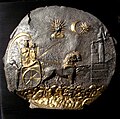
![Ionic pillar, cella of the Temple of the Oxus, Takht-i Sangin, late 4th - early 3rd century BCE.[43]](http://upload.wikimedia.org/wikipedia/commons/thumb/0/03/Ionic_pillar%2C_cella_of_the_Temple_of_the_Oxus%2C_Takht-i_Sangin%2C_late_4th_-_early_3rd_century_BCE.jpg/80px-Ionic_pillar%2C_cella_of_the_Temple_of_the_Oxus%2C_Takht-i_Sangin%2C_late_4th_-_early_3rd_century_BCE.jpg)
![Head of a Greco-Bactrian ruler with diadem, Temple of the Oxus, Takht-i Sangin, 3rd–2nd century BCE. This could also be a portrait of Seleucus I.[45]](http://upload.wikimedia.org/wikipedia/commons/thumb/0/0d/Head_of_a_Greco-Bactrian_ruler%2C_Temple_of_the_Oxus%2C_Takht-i-Sangin%2C_3rd-2nd_century_BCE.jpg/89px-Head_of_a_Greco-Bactrian_ruler%2C_Temple_of_the_Oxus%2C_Takht-i-Sangin%2C_3rd-2nd_century_BCE.jpg)
![Hellenistic silenus Marsyas from Takhti Sangin, with dedication in Greek to the god of the Oxus, by "Atrosokes" (a Bactrian name). Temple of the Oxus, Takht-i Sangin, 200–150 BCE. Tajikistan National Museum.[43][46]](http://upload.wikimedia.org/wikipedia/commons/thumb/5/51/Altar_to_God_Oxus%2C_with_Marsias_playing_the_aolos%2C_Temple_of_the_Oxus%2C_Takht-i_Sangin%2C_dated_2nd_century_BCE.jpg/80px-Altar_to_God_Oxus%2C_with_Marsias_playing_the_aolos%2C_Temple_of_the_Oxus%2C_Takht-i_Sangin%2C_dated_2nd_century_BCE.jpg)
![Alexander-Herakles head, Takht-i Sangin, Temple of the Oxus, 3rd century BCE.[43]](http://upload.wikimedia.org/wikipedia/commons/thumb/9/93/Alexander-Herakles_head%2C_Takht-i_Sangin%2C_Temple_of_the_Oxus%2C_3rd_century_BCE.jpg/90px-Alexander-Herakles_head%2C_Takht-i_Sangin%2C_Temple_of_the_Oxus%2C_3rd_century_BCE.jpg)